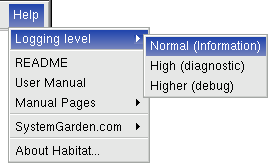Diagnostics
The ghabitat tool has the same logging & diagnostic mechanism as the rest of the habitat suite. Thus, if there are issues habitat's deployment, it can often be diagnosed using tools present in the graphical suite. The section below explains some of the features available to look at that information, which ideally should be read in conjunction with the Administration manual.
Log Configuration

Selecting this client->log routes shows a mapping of log severity to route. By default, this is normally set to the following:-

There are six severities, ranging from fatal to debug; nosev is a special severity conventionally discarding any inputs.
The route column indicates which route will be used to send or store log information. In the screen shot above, only two are used: none and gtkgui, both of which are route drivers without addressing. None discards any logs sent to it and in the example above, any messages less important than 'info' are thrown away. Gtkgui is a special driver provided by ghabitat that routes message logs into the graphical environment.
The log route can be customised by setting directives on the command line or in configuration files. For example, it may be useful to send logs to stderr or to a file (with the address file:filename).
Collecting Less Severe Logs
In the default configuration, only logs of severity 'info' and above are collected by the application for displaying in the main viewing area or the popup window. To collected the less severe logs 'diag' or 'debug', use the menubar item Help->Logging level.

A High logging level will include diagnostic messages which are of general help in configuration errors. A Higher level will include debugging messages, useful when diagnosing or debugging application issues. Normal will return the collection of logs to the default state.
Viewing Logs from the Choice Tree
Selecting the this client->logs node from the choice tree displays a list of all the log messages sent to the gtkgui driver. By default, these are messages with severity of 'info' and greater but can be altered using Help->Logging level from the menubar, as covered above.
When selected a display similar to the one below is shown in the visualisation area

Arranged for optimum viewing is the time, severity and message of each log. However, each entry also contains the origin of the message, useful for diagnosing problems with system garden support. This takes the form of function name, file name and line number and is available by scrolling the list to expose the right hand side. As with other tabular displays in the viewing area, double clicking on any row will display the row contents in a column list inside a popup for greater inspection.
The most recent log message is always displayed in the status bar at the bottom of the main window.
Dynamic Viewing of Logs from Statusbar
Logs
can also be shown by clicking the 'bomb' button on the status bar
![]() which produces a popup that holds log messages, similar to selecting
it from the choice tree. However, in this window, the logs will be
updated dynamically, appending new ones as they are created. Also,
the main viewing area is now free to be used for the rest of the
application, whilst still being able to see logs. This helps in
problem diagnosis.
which produces a popup that holds log messages, similar to selecting
it from the choice tree. However, in this window, the logs will be
updated dynamically, appending new ones as they are created. Also,
the main viewing area is now free to be used for the rest of the
application, whilst still being able to see logs. This helps in
problem diagnosis.
The dynamic logs window also has other features to aid understanding. Rows can be coloured depending on the severity of the message: black for fatal, red for error and so on. For long log histories, messages can be filtered for severity, independent of the collection of the logs. Finally, the log origin is also available by clicking for detailed message, which will widen the list being displayed.
An example is shown below of detailed coloured logs, all of 'info' severity.

